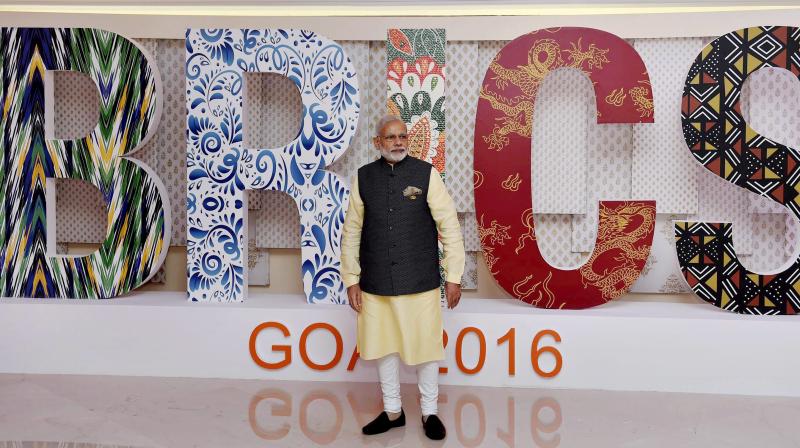For India, Brics is still a challenge & opportunity
The inaugural Bric summit (South Africa joined later in 2010, making it Brics) was held in Russia in June 2009.

Early into my tenure as India’s ambassador in Seoul in 2012, at a round table discussion on India-Korea ties, a participant representing a leading think tank asked: “Ambassador, don’t you think there is something amiss in Brics?” He went on to remark that “K” (Korea) was missing, and that a more apt acronym would be “Bricks”!
The inaugural Bric summit (South Africa joined later in 2010, making it Brics) was held in Russia in June 2009, on the heels of the maiden G-20 summit in November 2008 in Washington, when the world was in the throes of a financial crisis, the likes of which were rarely seen since the 1929 Great Depression. I was fortunate to have a ringside view of both events as a member of Prime Minister Manmohan Singh’s delegation.
As major economies saw their growth rates turn negative and iconic Western financial institutions went under, China and India among the Bric economies stood out like a beacon. In 2009, China and India registered GDP growth rates of 9.2 and 8.2 percentage points respectively. A short and succinct Bric joint statement noted: “We stress the central role played by the G-20 summit in dealing with the financial crisis” (para 1) and “We are committed to advance the reform of international financial institutions, so as to reflect changes in the global economy” (para 3). Bric had arrived, and a number of countries were contemplating joining it.
As the 10th Brics summit is being held in Johannesburg from July 25 to 27, it is appropriate to evaluate the group’s balance sheet and its utility for India. According to London’s Financial Times (September 1, 2017), Brics “has progressively realised its development agenda and made a significant contribution to the steady and consistent growth of the world economy”.
Expanding at a rapid clip, Brics now accounts for 23 per cent of global GDP and almost 50 per cent of the world’s population. In 2017, the nominal GDP of China, India, Brazil, Russia and South Africa (in trillions of dollars) was 11.94, 2.44, 2.1, 1.47 and 0.34 respectively. And therein lies India’s opportunity and challenge.
Brics has been the most successful as an economic grouping. Its biggest achievement is the establishment of the New Development Bank (NDB) in 2015, with a capital of $100 billion, of which $40 billion has been contributed or committed by China and $18 billion each by India, Brazil and Russia. It aims to finance infrastructure projects in member nations as well as fellow developing countries. The NDB is headquartered in Shanghai and has regional centres in South Africa and Brazil.
India has floated the idea of setting up a Brics Credit Rating Agency (BCRA) as it feels (as do many other nations) that Western agencies like Standard & Poor’s, Moody’s and Fitch, that control 90 per cent of the segment, are biased against the developing countries. The proposal is expected to be discussed during the ongoing 10th summit. However, China in particular does not appear to be very keen about it, wondering aloud about the credibility of a credit rating agency led by governments. Since the financial world is still dominated by the Western players, there are legitimate concerns about the BCRA’s ability to access critical financial data and commercial intelligence in real time.
Over the decade Brics has grown in ambition. Its leaders are also likely to discuss global hotspot issues, international peace and security matters, global governance, trade issues, etc, besides cooperation in areas like the Fourth Industrial Revolution, multilateralism, global governance, climate change, health and vaccines, peacekeeping, the network of science parks, and technology, infrastructure and collaboration in multilateral forums. Here the grouping’s role is evolving. Limitations are also imposed by the asymmetric capability, capacity, outlook and ambition of its member states.
The growing Chinese assertiveness, ambition and muscle is a reality that can’t be overlooked, especially by New Delhi, which has fraught bilateral relations with Beijing, despite the May 2018 Wuhan summit. The Chinese economy is now five times that of India’s and the gap is increasing. Even to maintain the status quo, India needs to grow at 10 per cent and China at two per cent annually, which is inconceivable any time in the foreseeable future. China’s money power and influence peddling is evident in South Asia and Africa, a continent with which India has traditionally enjoyed warm ties. Beijing is busy developing a blue-water navy for the first time in its history and setting up military bases around India in Pakistan (Gwadar) and Djibouti.
On issues of importance and concern to India like permanent membership of the UN Security Council and terrorism emanating from Pakistan, Brics (China and even Russia) has at best been paying lip service. Over 10 years the formulation of joint statements has more or less remained the same: “China and Russia reiterate the importance they attach to the status and role of Brazil, India and South Africa in international affairs and support their aspiration to play a greater role in the UN” (Xiamen summit 2017). For the first time, the Xiamen declaration “express(ed) concern on the — violence caused by the Taliban, ISIL/Daesh, the Haqqani Network, Lashkar-e-Tayyaba, Jaish-e-Mohammad, TTP and Hizbut-Tahrir”. Pakistan was not named. The impact, if any, is yet to be seen.
That said, while trilateral forums like RIC (Russia, India and China) and IBSA (India, Brazil and South Africa) have perhaps outlived their utility, Brics is steadily gaining in salience. India is rightly giving it due importance and has stayed fully engaged. However, New Delhi does need to guard against the inevitable Chinese attempts to hijack the Brics agenda. In time, there may be a good case for admitting tiger economies like South Korea and Indonesia to further expand the role, reach and standing of Brics.
H10

